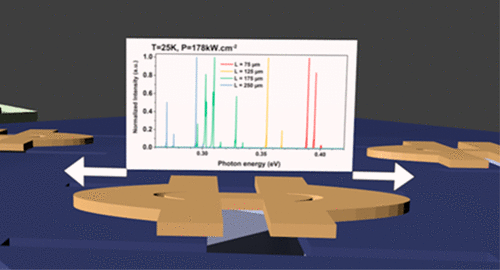当前位置:
X-MOL 学术
›
ACS Photonics
›
论文详情
Our official English website, www.x-mol.net, welcomes your
feedback! (Note: you will need to create a separate account there.)
GeSn Lasers Covering a Wide Wavelength Range Thanks to Uniaxial Tensile Strain
ACS Photonics ( IF 6.5 ) Pub Date : 2019-09-11 , DOI: 10.1021/acsphotonics.9b00712 Jérémie Chrétien 1 , Nicolas Pauc 1 , Francesco Armand Pilon 2, 3 , Mathieu Bertrand 4 , Quang-Minh Thai 1 , Lara Casiez 4 , Nicolas Bernier 4 , Hugo Dansas 4 , Patrice Gergaud 4 , Eric Delamadeleine 1 , Rami Khazaka 4 , Hans Sigg 2 , Jerome Faist 3 , Alexei Chelnokov 4 , Vincent Reboud 4 , Jean-Michel Hartmann 4 , Vincent Calvo 1
ACS Photonics ( IF 6.5 ) Pub Date : 2019-09-11 , DOI: 10.1021/acsphotonics.9b00712 Jérémie Chrétien 1 , Nicolas Pauc 1 , Francesco Armand Pilon 2, 3 , Mathieu Bertrand 4 , Quang-Minh Thai 1 , Lara Casiez 4 , Nicolas Bernier 4 , Hugo Dansas 4 , Patrice Gergaud 4 , Eric Delamadeleine 1 , Rami Khazaka 4 , Hans Sigg 2 , Jerome Faist 3 , Alexei Chelnokov 4 , Vincent Reboud 4 , Jean-Michel Hartmann 4 , Vincent Calvo 1
Affiliation

|
Silicon photonics continues to progress tremendously, both in near-infrared datacom/telecoms and in mid-IR optical sensing, despite the fact a monolithically integrated group IV semiconductor laser is still missing. GeSn alloys are one of the most promising candidate materials to realize such devices, as robust lasing under optical pumping was demonstrated by several groups up to mild cryogenic temperatures. Ideally, the integrated lasers should be tunable by design over a wide spectral range, offering a versatility that is required for optical sensing devices. We present here an innovative approach, taking advantage of local strain management in the semiconductor laser’s active zone. Arrays of differently strained Fabry-Pérot GeSn microlasers were fabricated side-by-side on the very same chip after blanket epitaxy on a Ge-buffered silicon-on-insulator substrate. Thanks to the local strain design, laser emission over a very large wavelength range under optical pumping, with laser lines peaking from 3.1 up to 4.6 μm at 25 K and with thresholds lower than 10 kW·cm–2. Laser operation persists up to 273 K, that is, very close to room temperature. This strategy, implemented on group IV semiconductors, opens up a new route to control the emission properties of microlasers integrated on a chip over significant photon energy windows representing a significant step forward in the integration and miniaturization of light sources emitting at a process-defined wavelength.
中文翻译:

单轴拉伸应变可覆盖宽波长范围的GeSn激光器
硅光子学在近红外数据通信/电信和中红外光感测中都继续取得巨大进步,尽管单片集成的第IV组半导体激光器仍然不见了。GeSn合金是实现此类器件的最有前途的候选材料之一,因为光学泵浦下的稳固激射已被多个小组证明,并达到了适度的低温。理想情况下,集成激光器应可在较宽的光谱范围内通过设计进行调谐,从而提供光学传感设备所需的多功能性。我们在这里提出一种创新的方法,利用半导体激光器活动区中的局部应变管理。在Ge缓冲绝缘体上硅衬底上进行外延外延之后,在同一芯片上并排制造了应变不同的Fabry-PérotGeSn微激光器阵列。得益于局部应变设计,在光泵浦下,激光可以在非常大的波长范围内发射,在25 K时,激光线的峰值从3.1到4.6μm,并且阈值低于10 kW·cm–2。激光操作持续到273 K,即非常接近室温。在IV组半导体上实施的这一策略开辟了一条新的途径,可以控制集成在芯片上的微激光器在显着的光子能量窗口上的发射特性,这代表了在以过程定义的波长发射的光源的集成和小型化方面的重大进步。
更新日期:2019-09-11
中文翻译:

单轴拉伸应变可覆盖宽波长范围的GeSn激光器
硅光子学在近红外数据通信/电信和中红外光感测中都继续取得巨大进步,尽管单片集成的第IV组半导体激光器仍然不见了。GeSn合金是实现此类器件的最有前途的候选材料之一,因为光学泵浦下的稳固激射已被多个小组证明,并达到了适度的低温。理想情况下,集成激光器应可在较宽的光谱范围内通过设计进行调谐,从而提供光学传感设备所需的多功能性。我们在这里提出一种创新的方法,利用半导体激光器活动区中的局部应变管理。在Ge缓冲绝缘体上硅衬底上进行外延外延之后,在同一芯片上并排制造了应变不同的Fabry-PérotGeSn微激光器阵列。得益于局部应变设计,在光泵浦下,激光可以在非常大的波长范围内发射,在25 K时,激光线的峰值从3.1到4.6μm,并且阈值低于10 kW·cm–2。激光操作持续到273 K,即非常接近室温。在IV组半导体上实施的这一策略开辟了一条新的途径,可以控制集成在芯片上的微激光器在显着的光子能量窗口上的发射特性,这代表了在以过程定义的波长发射的光源的集成和小型化方面的重大进步。


















































 京公网安备 11010802027423号
京公网安备 11010802027423号